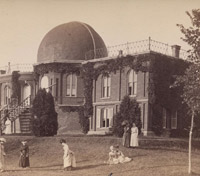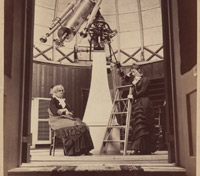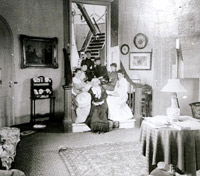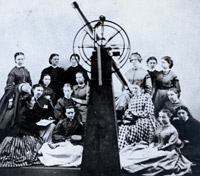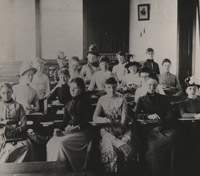The History of Physics and Astronomy at Vassar College
by Debra Elmegreen, Professor of Astronomy on the Maria Mitchell Chair and Chair of Physics and Astronomy
January 2011
Department Website
The Astronomy Department was established at the opening of Vassar Female College in 1865, and the Observatory was the first building completed on campus. The first professor and director of the observatory was Maria Mitchell. Matthew Vassar, unlike many of his contemporaries, wanted not only to educate women, but also to hire prominent women as professors to inspire the new students, and Maria Mitchell presented a rare opportunity. Maria, having grown up in a Quaker family in Nantucket, was educated along with her brothers and sisters. Her father was an amateur astronomer and repairer of navigation equipment for the sea-faring community. The result was that Maria knew the sky well. She gained international prominence when King Frederick VI of Denmark bestowed upon her a gold medal in 1847 for the first telescopic discovery of a comet. She became known as America's first female astronomer, and was the first woman elected a Fellow of the American Academy of Arts and Sciences. She was also a strong proponent of women's rights, promoting issues ranging from salary equality to suffrage.
The first astronomy course at Vassar had an emphasis on mathematical astronomy for calculating orbits of binary stars and comets, measuring sunspot motions, and determining eclipse times. Describing her course, Maria said, "…the recitation is half a conversational lecture and half questions and answer. I allow them great freedom of questions and they puzzle me daily. They show more mathematical ability than I had expected and more originality of thought. I doubt if young men at that age would take as much interest in science." Today, young men and women alike are engaged in astrophysics and observational astronomy courses.
The Vassar Observatory originally housed a 12-inch refractor telescope, which was the 3rd largest in the country at the time; the brass and mahogany telescope made by the famed telescope designer Henry Fitz is now on display at the Smithsonian Institution's Museum of American History in Washington, DC. Professor Mitchell emphasized that students should learn by doing, not by reading; this tradition of engaging students in research continues today. Her diary recounts how she would set out small telescopes for students to use all day and evening for measuring the rotation of the sun from sunspots, and measuring motions of moons around planets. Even though Maria emphasized mathematical rigor in the classroom, she remarked that "We especially need imagination in science. It is not all mathematics, nor all logic, but it is somewhat beauty and poetry." A progressive and adventurous woman, Maria led a student expedition cross country to witness a solar eclipse in Iowa in 1869 and in Denver in 1878.
When Maria came to Vassar, she and her father lived in the rooms attached to the observatory, and commonly entertained students there. She started a tradition of hosting Dome Parties at the end of each academic year, where her students would gather at the observatory to read poems about each other and astronomy. This tradition continues today at the new observatory.
In 1889, Maria's student Mary Whitney became director of the observatory and department chair, followed by Caroline Furness in 1915 and Maud Makemson in 1936. Over 200 hand-poured photographic emulsions from the late 1800's and early 1900's, capturing images of sunspots, variable stars, and binary stars that were the focus of early research at the observatory, are housed in the Vassar Library's Special Collections archive.
The first physics course at Vassar, taught in 1866, was titled Natural Philosophy. Physics and Chemistry were combined as one department in the 1870's, with a location in Main Building. The Vassar Brothers Laboratory was built in 1880, and upon further expansion, Physics became a separate department in 1894, with LeRoy C. Cooley serving as the first chair; he was succeeded by Alfred C. Cole. The current Sanders Laboratory of Physics was completed in 1926. In 1959, the Astronomy and Physics departments merged, with Ellinor F. Belding as the chair. The merge was logical since astronomy majors also require a strong physics background. Students in the department today may major in physics or astronomy, or double-major in both. Astronomer Henry Albers, the first male director of the Vassar Observatory, and physicist Robert Stearns alternated as chair in subsequent years. In 1990, Frederick Chromey (Professor of Astronomy on the Matthew Vassar, Jr. Chair) became Observatory Director, and the department chair in recent years has alternated between Debra Elmegreen (Professor of Astronomy on the Maria Mitchell Chair and President of the American Astronomical Society) and Cindy Schwarz, Professor of Physics.
In 1998, the Class of '51 Observatory was built on Sunset Hill. It houses a 32" reflecting telescope (tied for the largest in New York State), 20" reflecting telescope, and an Alvan Clark 8" refractor, in 3 separate domes. On display at the observatory is a brass plaque of Mary Whitney. Students are employed at the Observatory to do CCD imaging and spectroscopy of stars and quasars for research and coursework, and host weekly open nights. The old Observatory has been renamed the Maria Mitchell Observatory and was placed on the Register of National Historic Landmarks in 1991. The refurbished building now houses the Education Department, but retains the flavor of its origins. A bust of Maria Mitchell graces the central stairway, the entryway boasts photographs and quotations from Maria Mitchell, and the dome of the observatory now shelters a reading room.
The current astronomy program is part of the Keck Northeast Astronomy Consortium, a collaboration of astronomers at eight colleges founded in 1990 with the goal of exchanging summer students (now as a National Science Foundation Research Experience for Undergraduates site) and sharing research and education ideas. An annual student symposium, hosted on a rotating basis among the member institutions, provides an opportunity for students to present their summer research. Current astronomy research at Vassar, besides studies at the observatory using imaging of variable objects such as quasars, and stellar spectroscopy, involves using Hubble Space Telescope and Spitzer Space Telescope data to study the evolution of galaxies.
Physics research in the department in the 1960's and 1970's often involved experimental particle physics using the accelerator at the Brookhaven National Lab. Research interest has shifted over the years, and in the 1990's and 2000's, the physics laboratories have evolved to include an optics lab (Prof. Jenny Magnes), ultrafast laser lab (Prof. Brian Daly), and acoustics lab (Prof. David Bradley), which all engage students in research projects during the year and during the summer through Vassar's URSI program. The applied optics research laboratory includes an optics bench for research in spectroscopy, nano-materials, quantum optics, biophysics, and opto-mechanical methods. The ultrafast optics lab includes picosecond pulsed lasers for research on thin solid films and nanostructures. The acoustics lab features a reverberation chamber and acoustic and signal processing equipment, primarily for research on acoustic scattering, architectural acoustics, and musical acoustics. Computational methods are also employed in the research. Physics instruction has continued to evolve as well, as the adoption of interactive learning methods in the classroom has adhered to Maria Mitchell's admonition that students should learn by doing.
Vassar is a partner with the Dartmouth Thayer School of Engineering program, in which students earn both Vassar AB and Dartmouth engineering undergraduate degrees; many Vassar physics majors participate in the exchange program each year.
The department typically graduates about a dozen physics and astronomy majors annually. Prominent early graduates of the department include Antonia Maury, class of 1888, who became a "computer" at the Harvard College Observatory and a pioneer in the classification of stellar spectra, and Adelaide Ames, class of 1923, who worked with Harlow Shapley at Harvard to produce a catalog of galaxies still in use today. Other superstar alums include Dr. Vera Cooper Rubin, astronomy class of 1948, who received the National Medal of Science and worldwide honors for her pioneering work on dark matter in the universe, and Dr. John Carlstrom, physics class of 1981, who is a MacArthur Fellow at the University of Chicago studying cosmology by measuring the cosmic microwave background from a research station in Antarctica. In her autobiography, Vera Rubin remarked that "We have peered into a new world, and have seen that it is more mysterious and more complex than we had imagined. Still more mysteries of the universe remain hidden. Their discovery awaits the adventurous scientists of the future. I like it this way." Dr. Rubin and her husband and physicist Robert Rubin endowed a research fund for Vassar astronomy and physics students to provide more opportunities through assistance with small equipment or travel to other research labs, observatories, and conferences, which would undoubtedly have made Maria Mitchell smile.
References
- Albers, Henry, 2001, Maria Mitchell: a life in journals and letters, College Avenue Press, Clinton Corners, NY
- Daniels, Elizabeth, 1996, Main to Mudd and More, Vassar College, Poughkeepsie, NY
- Daniels, Elizabeth, Vassar Encyclopedia (online)
- Kendall, Phoebe Mitchell, 1896, Maria Mitchell: Life, Letters, and Journals, Lee & Shepard, Publishers, Boston, MA (Vassar online Collections)
- Rubin, Vera C. 1997, Bright Galaxies, Dark Matters, Masters of Modern Physics Series, AIP Press
- Steerman, James and Daniels, Elizabeth, We are Women Studying Together, a videotape, Vassar College Archives
- Wright, Helen, 1997, Sweeper in the sky: the life of Maria Mitchell, College Avenue Press, Clinton Corners, NY

